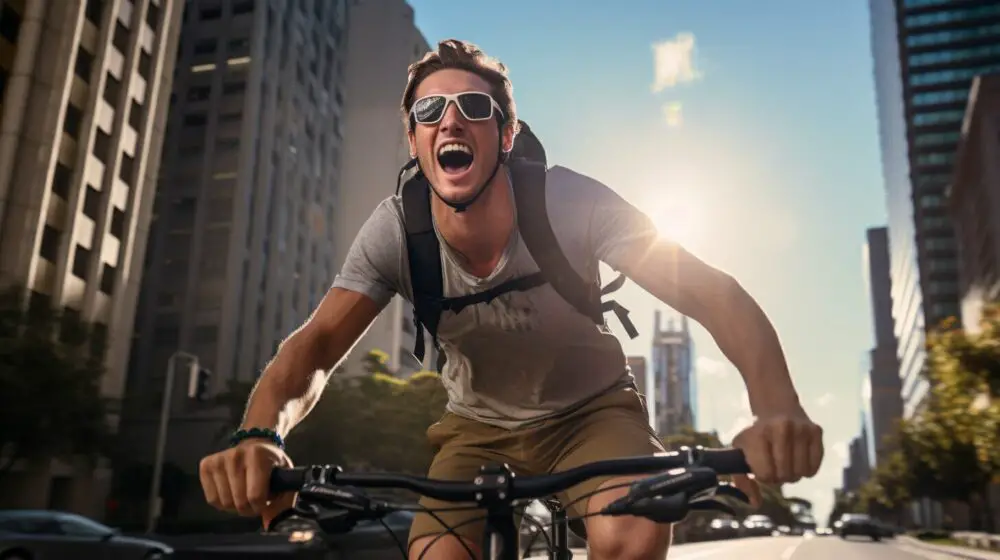Are you ready to take your biking skills to the next level? Learn how to ride a bicycle with no hands like a pro and improve your bike handling abilities. Practicing riding with no hands can enhance your balance and control, allowing you to perform tasks like adding or removing layers and fueling up on the bike with ease. By shifting your weight into the seat, tilting your pelvis back, engaging your core, and looking ahead, you can confidently ride without holding onto the handlebars.
To start, remove one hand from the bar, then the other, and finally lift both hands off the bars gradually. Use your core and hips to maintain balance and smoothly navigate turns. It’s important to practice in a safe area and progress gradually, ensuring your comfort and confidence in riding no hands.
Riding with no hands is not just a cool skill to master, but also a practical one that can significantly improve your overall bike handling. Remember to maintain a smooth pedal stroke, as this contributes to better stability and control, especially when riding a new bike.
Here are some key takeaways to keep in mind:
- Practice riding with no hands in a safe area
- Progress gradually, starting with one hand off the bars
- Use your core and hips to maintain balance
- Maintain a smooth pedal stroke for better bike handling
- Be considerate of others when riding in a group
Remember, practice makes perfect! The more you practice, the more comfortable and skilled you will become in riding a bicycle with no hands. So grab your bike, find a safe area, and start honing your bike handling abilities. Before you know it, you’ll be riding with no hands like a pro.
In the next section, we’ll delve deeper into the benefits of riding with no hands and why it’s worth mastering this skill. Stay tuned!
Why Ride With No Hands?
Riding a bicycle with no hands isn’t just for show – it can significantly improve your bike handling skills and offer more control during various situations. When you can confidently ride without your hands on the handlebars, you enhance your balance and control, allowing for smoother transitions and more precise movements.
By mastering the skill of riding with no hands, you can perform tasks like adding or removing layers while on the bike, fueling up during a long ride, or even signaling to other cyclists without compromising your bike’s stability. It’s a practical skill that can make your cycling experience more enjoyable and efficient.
To ride a bicycle with no hands, it’s important to understand the correct technique. Start by shifting your weight into the seat and tilting your pelvis back slightly. Engage your core muscles to maintain balance and use your hips to steer and turn. Keep your gaze focused ahead to anticipate any obstacles or changes in direction.
To practice this skill, begin by removing one hand from the handlebars while maintaining control with the other hand. Gradually progress to lifting both hands off the handlebars, relying on your core strength and balance to keep the bike steady. Remember to start practicing in a safe area, such as an empty parking lot, and gradually increase the difficulty as you become more comfortable.
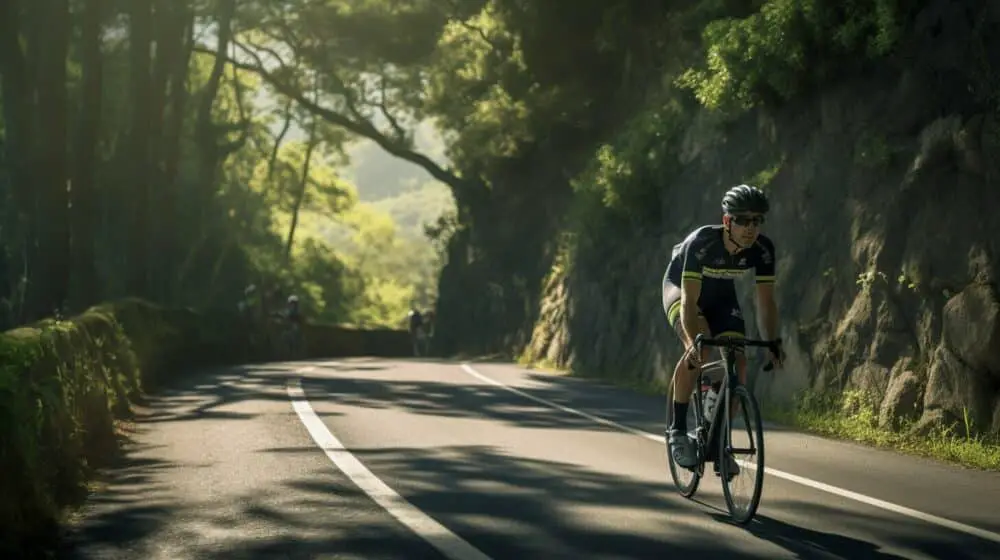
When riding with no hands, it’s crucial to maintain a smooth pedal stroke. This helps to improve bike handling and stability, especially when riding a new bike. By focusing on a fluid and efficient pedal stroke, you’ll enhance your overall control and balance.
When you’re ready to take your no hands riding skills to the road, there are a few important considerations. Choose flat sections of road without a bumpy surface to ensure a stable ride. Wait for a turn that puts the wind at your back, as this will provide additional stability. Be considerate of other road cyclists and avoid riding with no hands in gusty conditions or strong crosswinds.
It’s important to remember that riding a bicycle with no hands is a skill that can be improved with practice. Consistent practice and gradual difficulty progression will help you develop your bike handling skills and increase your confidence. Be prepared to relearn the process when riding a new bike, as each bike may have different handling characteristics.
So, embrace the challenge of riding a bicycle with no hands and reap the benefits of improved bike handling, control, and balance. Start practicing in a safe area, focus on a smooth pedal stroke, and gradually progress to riding with no hands on the road. With dedication and practice, you’ll become a pro in no time!
Mastering the Technique
Mastering the technique of riding a bicycle with no hands starts with proper weight shift, core engagement, and a focus on balance and turning. By following these steps, you can learn to ride confidently and safely without holding onto the handlebars.
To ride with no hands, begin by shifting your weight into the seat. This will help stabilize your body and distribute your weight evenly. Tilt your pelvis back slightly to maintain a centered position and engage your core muscles to provide additional support and control.
Next, focus on maintaining balance and turning smoothly. Look ahead in the direction you want to go, and use subtle shifts in your hips and core to control the bike’s movements. As you become more comfortable, you can start by removing one hand from the handlebars, then the other, gradually lifting both hands off the bars.
Remember to practice in a safe area and progress gradually. Start in a spacious and empty parking lot to avoid any obstacles or hazards. Ensure that your bike is in good repair, with properly inflated tires and functioning brakes. Riding on a smooth surface will make it easier to maintain balance and control.
| Practice Tips: |
|---|
| Start by removing one hand from the handlebars and gradually progress to lifting both hands off. |
| Use your core and hips to maintain balance and control while turning. |
| Practice in a safe area, such as an empty parking lot, and progress gradually. |
| Ensure your bike is in good repair, with properly inflated tires and functioning brakes. |
By mastering the technique of riding a bicycle with no hands, you can improve your bike handling skills and enhance your overall cycling experience. Remember to maintain a smooth pedal stroke to further optimize your control and stability, particularly when riding a new bike. With practice, patience, and a focus on safety, you’ll soon be riding confidently and effortlessly without holding onto the handlebars.
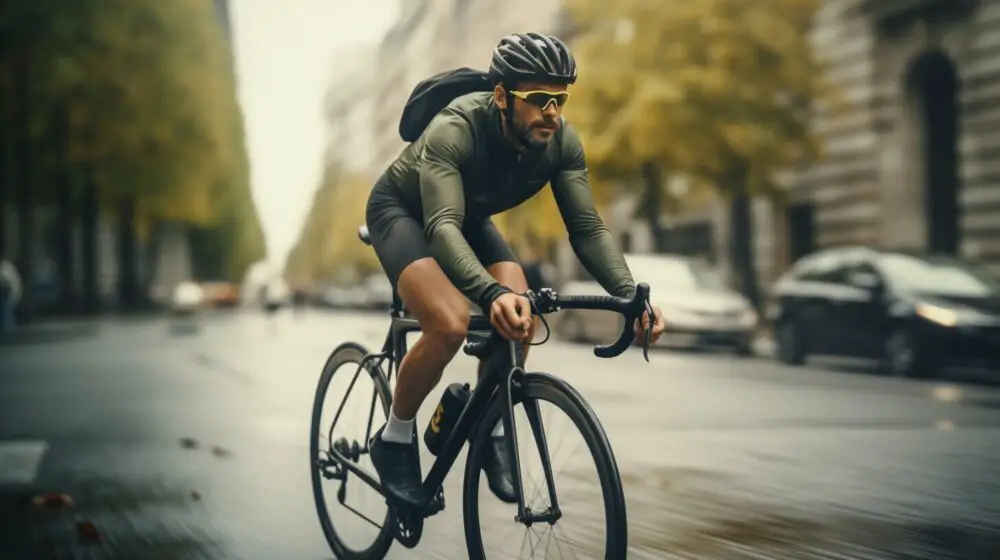
Safe Practice Tips
Safety should always be the top priority when practicing riding with no hands. Here are some important tips to keep in mind for safe and effective practice sessions:
- Find a safe area: Look for an empty parking lot or a quiet street with minimal traffic to practice riding with no hands. This will minimize the risk of accidents and allow you to focus on mastering the technique.
- Check your bike: Before attempting to ride with no hands, ensure that your bike is in good repair. Check the brakes, tires, and overall stability of the bike to reduce any potential risks.
- Avoid bumpy surfaces: It’s best to practice on smooth surfaces to maintain better control and stability. Avoid rough or uneven paths that could cause you to lose balance.
- Be cautious of crosswinds and gusty conditions: Riding with no hands can be more challenging in windy conditions. Avoid practicing on windy days or choose sections with less exposure to gusts.
- Considerate group riding: If you’re riding in a group, it’s important to be mindful of others. Only ride with no hands at the back of the group to avoid causing potential collisions or disrupting the flow of other riders.
By following these safe practice tips, you can enhance your skills in riding a bicycle with no hands while minimizing any potential risks or accidents.
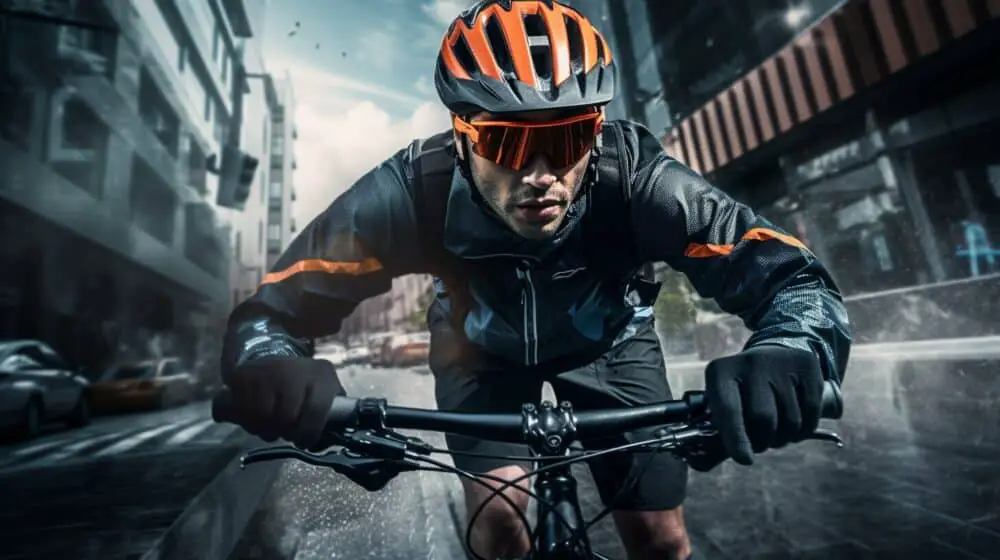
“Practicing safe and effective techniques will help you master riding with no hands.”
| Practice Tip | Description |
|---|---|
| Safety First | Prioritize safety by practicing in a safe area and ensuring your bike is in good repair. |
| Smooth Surfaces | Choose smooth surfaces to practice riding with no hands for better control and stability. |
| Avoid Crosswinds | Be cautious of crosswinds and gusty conditions that can make riding with no hands more challenging. |
| Considerate Group Riding | When riding in a group, only ride no hands at the back to avoid disrupting others. |
The Importance of Smooth Pedaling
Achieving a smooth pedal stroke is crucial when riding a bicycle with no hands, as it enhances bike handling and stability, especially on unfamiliar bikes. By maintaining a consistent and fluid motion while pedaling, you can minimize unnecessary movements that could throw off your balance. A smooth pedal stroke allows you to distribute your weight evenly throughout the bike, optimizing your control and responsiveness.
When riding with no hands, your body position and posture play a vital role in maintaining stability. Engaging your core and keeping your pelvis tilted back helps center your weight closer to the saddle, reducing the likelihood of leaning too far forward or backward. This balanced position enables you to make subtle adjustments to your balance using your hips and core muscles, ensuring a smooth and controlled ride.
Practicing a smooth pedal stroke can also improve your bike handling skills overall. As you become more accustomed to maintaining a fluid motion, you’ll develop a heightened sense of control and finesse while riding. This control translates into better cornering, maneuvering, and navigating obstacles on the road. With a smooth pedal stroke, you’ll be able to confidently handle various terrains and situations, whether it’s a steep hill, a sharp turn, or a sudden change in road conditions.
| Benefits of a Smooth Pedal Stroke: |
|---|
| Enhanced bike handling and stability |
| Improved control and responsiveness |
| Efficient weight distribution |
| Increased core engagement and balance |
| Confidence in various riding conditions |
Remember, a smooth pedal stroke is not only essential for riding with no hands but also for enhancing your overall biking experience. So, next time you hit the road or trails, focus on maintaining a consistent and fluid motion while pedaling, and watch as your bike handling skills improve.
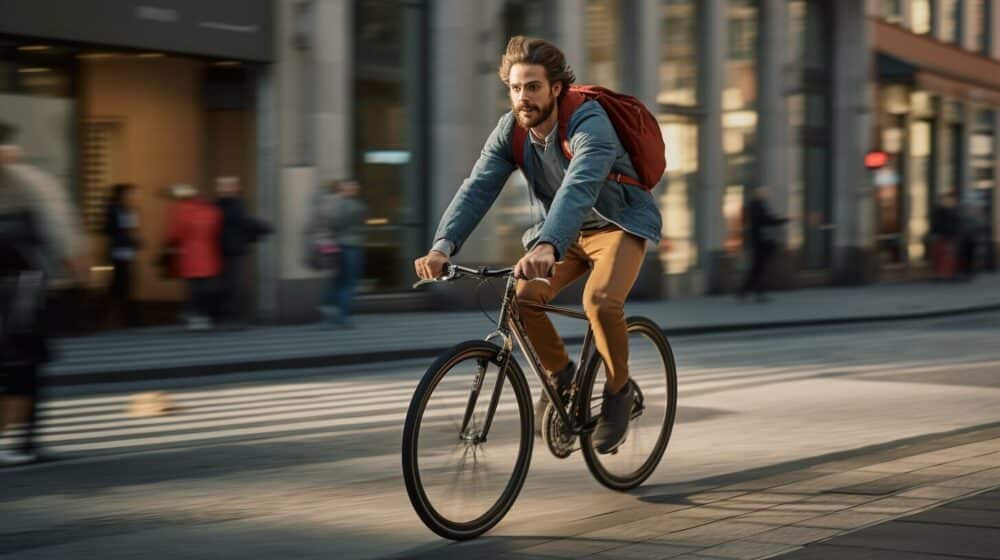
Riding No Hands on the Road
Riding a bicycle with no hands on the road requires extra caution and consideration. Here are some tips for safely enjoying this skill on the road.
- Choose flat sections without a bumpy surface to practice riding with no hands. Maintaining balance becomes easier on smooth roads.
- When attempting to ride no hands, wait for a turn that puts the wind at your back. This will provide more stability as you navigate the turn.
- Be considerate of others when riding in a group. If you want to ride no hands, make sure you are at the back of the group and out of the way of other cyclists.
- Avoid riding with no hands in strong crosswinds or gusty conditions. These weather conditions can make it difficult to maintain control of the bike.
Remember, riding a bicycle with no hands on the road is a skill that requires practice and experience. It is important to gradually build up your confidence and abilities. By following these tips and exercising caution, you can safely enjoy the freedom and thrill of riding no hands.

Table: Tips for Riding No Hands on the Road
| Tip | Description |
|---|---|
| Choose flat sections | Find smooth roads with no bumps to practice riding with no hands. |
| Pick the right conditions | Wait for turns that put the wind at your back to enhance stability. |
| Be considerate | Ride no hands at the back of a group to avoid interfering with others. |
| Avoid challenging weather | Strong crosswinds and gusty conditions can make it hard to maintain control. |
Progressing Your Skills
Like any skill, riding a bicycle with no hands requires practice and patience. Here’s how you can progress and enhance your abilities over time.
To start, practice removing one hand from the handlebars while maintaining control and balance with your other hand. Focus on shifting your weight into the seat, tilting your pelvis back, engaging your core, and looking ahead.
- Gradually progress to removing both hands from the handlebars, using your core and hips to maintain balance and control.
- Experiment with turning while riding with no hands, using subtle weight shifts and gentle handlebar pressure to guide your bike.
- As you gain confidence, try riding with no hands on different terrains, such as smooth roads or gentle inclines.
Consistent practice is key to improving your skills. Set aside dedicated time to practice riding with no hands, focusing on your technique and gradually increasing the duration of each practice session. Remember, progress may be slow at first, but with time and effort, you’ll become more comfortable and proficient.
Additional Tips for Skill Improvement:
- Record yourself practicing riding with no hands to review your technique and make adjustments.
- Seek guidance from experienced riders or consider taking a bike handling course to enhance your skill set.
- Challenge yourself with small goals, such as trying to ride with no hands for a longer distance or incorporating turns into your rides.
By consistently practicing and gradually pushing your limits, you’ll soon be able to ride a bicycle with no hands like a pro. Enjoy the freedom and confidence that comes with mastering this skill!
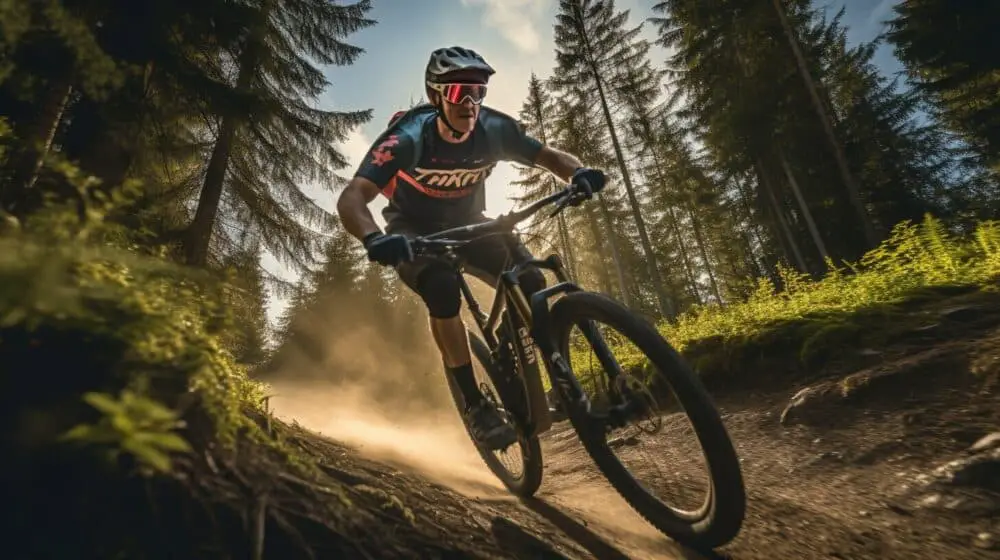
| Practice Tips | Skill Improvement |
|---|---|
| Focus on shifting weight into the seat, tilting pelvis back, engaging core, and looking ahead. | Record yourself practicing riding with no hands to review your technique and make adjustments. |
| Start by removing one hand from the handlebars, then progress to removing both hands. | Seek guidance from experienced riders or consider taking a bike handling course. |
| Experiment with turning while riding with no hands, using subtle weight shifts and gentle handlebar pressure. | Challenge yourself with small goals and incorporate turns into your rides. |
Conclusion
Riding a bicycle with no hands may seem challenging, but with practice and the right techniques, you can master this skill and take your bike handling to new heights. By gradually progressing from removing one hand from the handlebars to lifting both hands off, you can develop the balance and control necessary to ride with no hands.
Practicing in a safe area, such as an empty parking lot, is crucial to ensure your safety and the safety of others. It is also important to ensure that your bike is in good repair before attempting to ride with no hands. By maintaining a smooth pedal stroke, you can further enhance your bike handling skills and stability.
When venturing onto the road, choose flat sections without a bumpy surface and wait for a turn that puts the wind at your back. Be considerate of other road cyclists and avoid riding with no hands in strong crosswinds or gusty conditions. Remember to always ride no hands at the back when riding in a group.
In conclusion, riding a bicycle with no hands is a practical skill that can greatly improve your bike handling and overall bike skills. With dedication and consistent practice, you can confidently ride a bicycle with no hands like a pro, enjoying the benefits of improved balance, control, and the ability to perform tasks on your bike effortlessly.
FAQ
Q: Why should I ride a bicycle with no hands?
A: Riding with no hands can improve balance and control, allowing you to perform tasks like adding or removing layers and fueling up on the bike.
Q: How do I ride a bicycle with no hands?
A: To ride with no hands, shift your weight into the seat, tilt your pelvis back, engage your core, and look ahead. Start by removing one hand from the handlebars, then the other, and gradually lift both hands off. Use your core and hips to balance and turn.
Q: Where should I practice riding with no hands?
A: It’s important to practice in a safe area, such as an empty parking lot. Make sure your bike is in good repair and choose flat sections without a bumpy surface. Avoid riding no hands in strong crosswinds or gusty conditions.
Q: Do I need to relearn the process when riding a new bike?
A: Yes, it’s important to be prepared to learn the process again when riding a new bike. Each bike may have different balance and handling characteristics.
Q: Can I ride no hands in a group?
A: If you’re riding in a group, it’s best to be considerate of others and only ride no hands at the back. Safety and courtesy should always come first.
